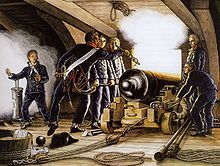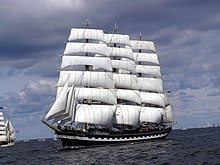Gun port

As gun ports (including gun ports ) the closable openings are referred to in the hull of warships, could, through firing by the posted inside the ship cannons pieces.
history
Gun ports are said to have been introduced around 1500 by the French shipbuilder Descharge. They were a necessary development in sailing warship building and could be found well into the 19th century. However, long before that there were large openings just above the waterline that could be closed. So the technology was known and was used e.g. B. applied when loading logs. The reason for this invention is the fact that a large number of heavy cannons on the upper deck of a ship shift the center of gravity upwards and make it unstable. For this reason, the possible armament was limited if one did not want to risk the seaworthiness of the ship. By placing the cannons on lower decks (the heaviest at the bottom), a much heavier armament became possible. In addition, a deep installation of cannons (as close as possible to the waterline) was inevitable, since only so much smaller or shallower ships such as z. B. let galleys be effectively fought by gunfire, which would not have been possible with upper deck cannons. The establishment of the gun ports and the relocation of the ship's artillery to several decks within the hull made it possible to solve these tasks.
In the centuries that followed, warship building and naval warfare tactics were geared towards concentrating as many cannons as possible in the broadsides and using them. With the advent of guns in rotating turrets in the 19th century, the gun ports for the main artillery became obsolete. However, modern variants of the gun ports were built into the hull and superstructure for medium artillery and smaller calibers.
construction
Gun ports are usually rectangular and wider than high. The corresponding openings of a deck are exactly opposite port and starboard. In the first years of the introduction of the gun ports, these were probably placed on the individual battery decks, directly below one another (e.g. on the Great Harry galleon from 1514). But depictions from the 1520s already show the staggered arrangement. This reduced the stress on the ship's hull caused by the recoil.

In addition to side gates, there were also rear and hunting gates, which were located in the stern and bow.
Several parts belonged to the gun port that made it possible to use it. After the gate cover, eyebolts were included in the ship's side. Usually there are four, two each next to the hatch. The lower pair was intended for the Brooktau and the upper pair for the Richtaljen . The Brooktau served to absorb the recoil and transmitted its energy to the hull. It was either placed with one eye over the grape (English variant) or sheared through the carriage (continental variant). After opening of the hatches, the mouths of the guns then were for targeting advanced ( "through the opening ausgerannt "). The Richttaljen were used to run out after the respective loading of the gun and the lateral alignment.

The lids were opened with a rope pull to the outside via the so-called gate stairway (a special rope) and closed using the closing staircase (also a special rope). There were both lid versions that are
- a) up or
- b) down and up or
- c) like swing gates on both sides
let open.
In the 15th century the gates cover (were Luke , gate , Pfortluke ) while locked from the inside and jammed with a bar on the ship's side.
To increase the impermeability to water, the edges of the closed lids were additionally sealed with greased cloths. Since the inside of the ship's side was colored red, the opened cover showed the red inside to the enemy. The color contrast showed the viewer readiness to fight. This threatening impression could be reinforced with lion mascarons (e.g. on the vasa ). The red color was supposed to hide the blood of its own crew that was splashed on hits.
Wrong gun ports

In the 19th century, false gun ports were also widespread, behind which there were no guns, but z. B. found only glass windows or nothing that had to do with armament. These versions with gate covers were mostly used on merchant ships and were intended to prevent potential attackers such as B. Deceive pirates about the actual weapon status and prevent them from attacking.
The tradition of guiding dummy gates has been maintained to this day, especially with many tall ships, by z. B. at the points of the ship's side where gun ports could be attached, rectangles are accentuated along the so-called Portenbandes in appropriate colors.
Other use
Gun ports can be used to load long goods in lower decks.
A ship's camel uses two opposite gun ports to exert lifting force on the ship - also - by means of wooden girders inserted through it.
literature
- zu Mondfeld, Wolfram, Historische Schiffsmodelle , special edition 2003, Orbis Verlag, Munich ISBN 3-572-01464-6
- Aufheimer, Hans, Ship Armament from the Beginning to the Middle of the 19th Century. A summary of ship armament from its beginnings to 1860 , Hinstorff-Verlag, Rostock 1983


